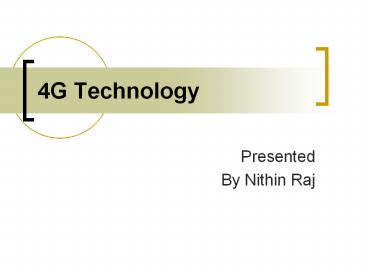4G Technology - PowerPoint PPT Presentation
Title:
4G Technology
Description:
4G Technology Presented By Nithin Raj 4G Definition 4G is not one defined technology or standard, but rather a collection of technologies at creating fully ... – PowerPoint PPT presentation
Number of Views:28820
Avg rating:3.0/5.0
Title: 4G Technology
1
4G Technology
- Presented
- By Nithin Raj
2
4G Definition
- 4G is not one defined technology or standard, but
rather a collection of technologies at creating
fully packet-switched networks optimized for
data. - 4G Networks are projected to provide speed of
100Mbps while moving and 1Gbps while stationary.
3
0G (Zero Generation Mobile System)
- At the end of the 1940s, the first radio
telephone service was introduced, and was
designed to users in cars to the public land-line
based telephone network. - In the 1960s, a system launched by Bell Systems,
called, Improved Mobile Telephone Service (IMTS),
brought quite a few improvements such as direct
dialing and more bandwidth. The very first analog
systems were based upon IMTS and were created in
the late 60s and early 70s.
4
1G Technology
- 1G refers to the first-generation of wireless
telephone technology was developed in 1970s. - 1G had two major improvements
- the invention of the microprocessor
- the digital transform of the control link between
the phone and the cell site. - Analog signal
5
2G Technology
- Around 1980s
- Better quality capacity - More people could use
there phones at the same time - Digital Signals consist of 0s 1s
6
Previous Technology - 2G
- Digital consist of 0s and 1s
- Digital signal
- 1.Low level, 2.High level, 3.Rising edge
- and 4.Falling edge
7
Previous Technology - 2G
- Digital data can be compressed and multiplexed
much more effectively than analog voice encodings - Multiplexing -multiple analog message signals or
digital data streams are combined into one signal
- For 1 and 2G standards, bandwidth maximum is 9.6
Kbit/sec, (I.E) approximately 6 times slower than
an ISDN
8
Previous Technology - 2G
- Allows for lower powered radio signals that
require less battery - PowerCODEC introduction -program that encodes
and decodes digital data stream or signal - Translates data from digital to analog and vice
versa
9
Previous Technology - 2G
10
Advantages in Previous Technology - 2G
- The digital voice encoding allows digital error
checking - increase sound quality
- lowers the noise level
- Going all-digital allowed for the introduction of
digital data transfer - SMS short message service
11
Disadvantages in Previous Technology - 2G
- Cell towers had a limited coverage area
- Jagged Decay curve
- Abrupt dropped calls
- Analog gradual sound reduction
- Spotty coverage
12
3G Technology
- Large capacity and broadband capabilities
- Allows the transmission of 384kbps for mobile
systems and up to 2Mbps - Increased spectrum efficiency 5Mhz
- A greater number of users that can be
simultaneously supported by a radio frequency
bandwidth - High data rates at lower incremental cost than
2GGlobal roaming
13
Previous Technology - 3G
- CDMA Code Division Multiple Access
- Form of multiplexing
- Does not divide up the channel by time or
frequency - Encodes data with a special code associated with
each channel
14
Code Division Multiple Access
15
Types of Multiplexing
- FDMA Frequency Division Multiple Access
- Each phone call is allocated one frequency for
the entire duration of the call
16
Types of Multiplexing
- TDMA - Time Division Multiple Access
- Each phone call is allocated a spot in the
frequency for a small amount of time, and "takes
turns" being transmitted
17
Types of Multiplexing
- CDMA - Code Division Multiple Access
- Each phone call is uniquely encoded and
transmitted across the entire spectrum, in a
manner known as spread spectrum transmission
18
Reasons for New Research
- Even though 3G has successfully been introduced
to mobile users, there are some issues that are
debated by 3G providers and users. - High input fees for the 3G service licenses
- Great differences in the licensing terms
- 3G phones are expensive
19
Fourth Generation
20
What is 4G?
- Fourth Generation Technology
- Faster and more reliable
- 100 Mb/s
- Lower cost than previous generations
- Multi-standard wireless system
- Bluetooth, Wired, Wireless
- Ad Hoc Networking
- IPv6 Core
- OFDM used instead of CDMA
- Potentially IEEE standard 802.11n
- Most information is proprietary
21
Communications Architecture
- Broadcast layer
- fix access points, (i.e.) cell tower connected by
fiber, microwave, or satellite (ISP) - Ad-hoc/hot-spot layer
- wireless LANs (i.e. internet at Starbucks)
22
Communications Architecture
- Personal Layer Gateway
- devices that connect to upper layers cell phone,
fax, voice, data modem, MP3 players, PDAs - Info-Sensor layer
- environmental sensors
- Fiber-optic wire layer
- high speed subterranean labyrinth of fiber optic
cables and repeaters
23
Ad Hoc Networks
- Spontaneous self organization of networks of
devices - Not necessarily connected to internet
- 4G will create hybrid wireless networks using Ad
Hoc networks - Form of mesh networkingVery reliable
24
Enhance Mobile Gaming
- Experience enhance wireless capabilities that
deliver mobile gaming interaction with less than
five seconds - Play online multi player games while traveling at
high speeds or sitting outside
25
Broadband access in Remote location
- 4G will provide a wireless alternative for
broadband access - I will provide first opportunity for broadband
access in remote locations without an
infrastructure to support cable or DSL access.
26
Thanking You































